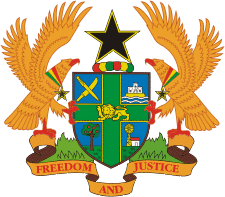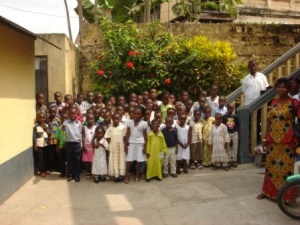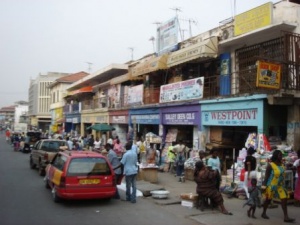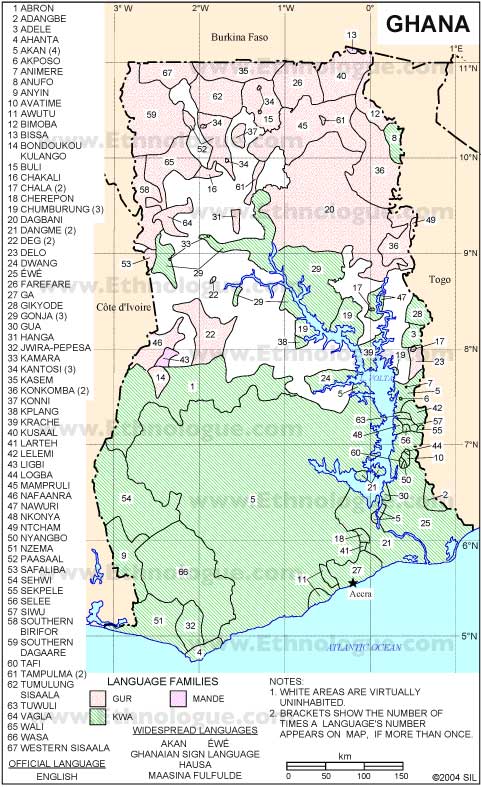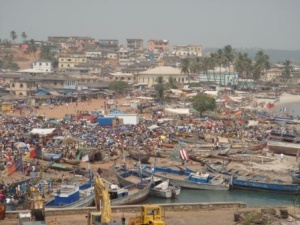Ghana
From The Peopling of New York City
Contents |
Location
Located in West Africa, Ghana is approximately 238,500 sq km in area, slightly smaller in area than the state of Wyoming (251,501 sq km). Ghana shares its western border with Côte d'Ivoire, eastern border with Togo, and northern border with Burkina Faso. Its southern boundary is the Gulf of Guinea, the Atlantic Ocean.
History
Historians have learned that the ancestors of many of Ghana's ethnic groups such including the Akan (Ashanti and Fanti), the Ewe, the Ga-Adangbe, the Mole-Dagbani, the Guan, and the Gurma entered their present territories by the 10th century A.D. These migrants established a society and civilization due to the location near the river systems of Africa as well as the Atlantic Ocean. The Kingdom of Ghana, one of the most primitive states of Ghana expanded significantly beginning in the 9th century until its collapse in the 11th century. The British then renamed Ghana. They renamed it to the Gold Coast. It was not until 1957 when it was officially renamed Ghana to represent it as one of the first independent African nations. Ghana became an important commercial center of trade. Ghana was made up of various city-states of specific ethnic groups. However it was the Ashanti Kingdom that was the most influential.
Under the control of the Ashanti tribe the Ashanti Kingdom, expanded rapidly into a unified empire. The rich gold coast of Ghana is what attracted the Europeans to the area; however the trans-Atlantic slave trade brought the greatest number of Europeans to the area during the period of European Imperialism. Slaves from Ghana were sent to North America, South America and the Caribbean. The coast of Ghana consisted of many slave-trading fortresses all under European control. The majority if these slaves were prisoners of war, criminals, yet a fair share of innocent people were taken as slaves as well. In exchange for the slaves, the Europeans gave the local rulers weapons. The British abolished slaved trading in 1807, but wanted to take complete control of this haven for trading. After many power-struggles and wars primarily with the Ashanti tribe the British finally took complete control of Ghana and declared it one of its colonies in 1874.
Under the British, Ghana railroad systems were set up and the Ghanaian economy flourished. The success of Ghana had much to do with the export of cacao (used to make chocolate). Missionaries established education for the Ghanaian youth in 1882. In the 1920s British colonial governor Gordon Guggisberg constructed several coed secondary schools and technical institutions, and continued to develop Ghana’s railroads and road systems. Guggisberg brought Africans into the colony’s civil service and appointed the first Ghanaians to the colonial Legislative Council. These improvements helped create a social environment which allowed for a rise in nationalism among the Ghanaians and gave strength to the independence movements seeking to end British rule.
The British immediately squashed the initial protests against taxes that occurred in the later half of the 19th century. In 1920 Joseph E. Casely-Hayford, a prominent African, Gold Coast lawyer and nationalist, organized the National Congress of British West Africa. This body of educated persons from Britain’s various West African colonies sent a delegation to the British Colonial Office in London to argue that its subjects should elect a colony’s administration. The British government did not agree to the demands. Early nationalists continued to urge the colonial government to initiate administrative changes through newspaper articles and speeches. Demands on the colonial government deepened after World War II. In 1946 Governor Alan Burns responded by announcing changes that made it possible for a majority African Legislative Council to be elected. These changes stipulated that executive power was to remain in the hands of the governor, to whom the legislative council reported. In 1946, the constitution provided the people of the Gold Coast with more political power than anywhere else in colonial Africa.
In 1947, the United Gold Coast Convention (UGCC) was the first nationwide political party to call for self-government. Under the leadership of Kwame Nkrumah, the UGCC led Ghana to complete independence. Through Nkrumah’s idea of “positive action” the Ghanaians boycotted foreign business, no longer cooperated with the government, and organized general workers’ strikes. In 1951 Nkrumah split from the UGCC to form the Convention People’s Party (CPP). The CPP won control of the government of an independent Ghana on March 6, 1957. Nkrumah became the country’s first prime minister. The UGCC and several other opposition parties joined together to form the United Party (UP). Ghana became the first sub-Saharan African nation to gain independence.
Nkrumah began his leadership of Ghana with high hopes and goals for the country. From 1961-1966 he implemented many programs to improve the economy of Ghana and felt it was his responsibility to help other African colonies gain independence. However Nkrumah became too authoritative and was overthrown in the late 1960s. In 1969 Kofi A. Busia, a former United Party leader and one of the nation’s leading scholars, was elected prime minister. The economy of Ghana, however, continued to deteriorate and inflation soared. The entire next two decades were plagued by economic and political struggle. It was not until the 1990s that some sort of political stability came to the region under the leadership of Jerry John Rawlings. Rawlings had once given up power of Ghana in 1979 to Hilla Limann, but regained control after the economy worsened under Limann. Ghana became recognized as a leader in a “new African renaissance”. In 2001 the first peaceful transition of power took place and Ghana continues to remain one of the prosperous nations on the African continent today. John Kufuor took control in 2001 and remains the president of Ghana today.
Demographics
Statistics current to 2006
People
Population, total: 23.0 million
Population growth (annual %): 2.1
Life expectancy at birth, total (years): 59.7
Fertility rate, total (births per woman): 3.9
Mortality rate, under-5 (per 1,000): 119.9
School enrollment, secondary (% gross): 45.9
Prevalence of HIV, total (% of population ages 15-49: 2.3
Economy
GNI, Atlas method (current US$) 11.8 billion
GNI PPP ($ millions), 2006 28.4 billion
GDP (current US$) 12.9 billion
GDP growth (annual %) 6.2
Inflation, GDP deflator (annual %) 14.6
Time required to start a business (days) 81.0
Military expenditure (% of GDP) 0.7
Fixed-line and mobile subscribers (per 100 people) 24.2
Internet users (per 100 people) 2.7
Roads, paved (% of total roads) 29.6
High-technology exports (% of manufactured exports) 0.2
Languages
Ghana is a country rich in diversity in the form of many different local tribes. The languages of Ghana are just as diverse, due to the fact that each tribe speaks its own language and each set of languages has its own dialect. Because Ghana was colonized by Great Britain, English language was always prominent and is the official language.
Each geographic region of Ghana is home to a specific set of languages. (See image above) In the northern region of the country, Gur is the language spoken. However, Gur has many different dialects including Mole-Dagbane, Grusi and Gurma. Most northerners understand Hausa, a Nigerian language that is acquired during trade. As you travel south, you will start to hear the Kwa language being spoken. Kwa is made up of the Fante-Twi, Ga and Ewe dialects. The other main languages that can be heard on radio and television include Akan, Ewe, Ga, Nzema, Dagbane and Hausa.
The written word in Ghana is most often written in English. However, the other written languages, which are all based in Latin script, include Twi dialects of Asante, Akwapim ,and Fante. Nzema, Ewe, Dagbane, Ga and Kasena are also used widely in the country.
Traditions
Ghana tradition has many celebrations related to personal milestones. Ghanaians celebrate the rites of passage of child-birth, puberty, marriage and death. Funeral celebrations last several days and attendance is normally expected from everyone that lives in the village. Funerals are so important to Ghanaians because it allows them to pay their last respects to their loved ones who have past on. It is shameful to the Ghanaians to not have a proper burial and funerals in Ghana are supposed to be expensive ceremonies. They are to show great respect for the deceased. In Ghana, there is much more attention focused on a lavish funeral than a wedding.
Panafest is held every summer in Ghana. Panafest celebrates Ghanaian roots. People from other African nations, as well as African-Americans, return to Ghana to celebrate their heritage. Ghanaians also celebrate the “Homowo” Festival, which celebrates the end of a famine that occurred earlier in Ghanaian history. Homowo actually translates into “making fun of hunger”. When the famine was over, the Ghanaians were so thrilled that they celebrated with a festival that mocks hunger. Festivals in Ghana typically consist of chiefs and queens of the local tribes dressed in eloquent clothing while natives play instruments and warriors shooting ancient muskets.
Weddings are very traditional in that they are typically arranged. Most marriages in Ghana are the union between cousins. The family of the groom is expected to "buy" the wife for a price. Polygamy is widely practiced and is a symbol of high status. Chiefs often have up to twelve wives. Having children is very important to Ghanaians. A groom will often divorce his wife if she is infertile. If a husband passes away, the wife is expected to marry the brother of her former groom. However western influence has changed the way Ghanaians wed. Currently, all Christians are expected to marry only one person and there is more freedom in choosing who you want to marry.
Ghanaians children are often given two names. At birth they are given a native name and when they begin school they are given a Christian name which is usually westernized. The native names given to children at birth are derived from whatever day of the week they are born on. It is often paired with a name to honor one of their ancestors.
Puberty is a very important time for everyone. In Ghana, puberty brings not only changes but many ceremonies and traditions as well. Young women have more ceremonies and rites of passage than the young men of Ghana. The Ghanaians believe that having a loving and supportive mother results in strong adults. Girls are taught from childhood to be graceful, caring and loving. After a young lady's first menstrual cycle, she is secluded from the community for two to three weeks where she is taught about the "secrets" of womanhood, sex education and birth control. They are also taught how to relate to men so they can have successful marriages. After the seclusion a "durbur" occurs with everyone in the community attending. The newly initiated women are beautifully, scantily dressed to show themselves off. According to tradition every woman must be a virgin before the seclusion. Every woman is mandated to go through with this right of passage. It is to educate and prevent premarital babies and unwanted births. The punishment for breaking these rules is usually ostracisms for both the male and female in question.
References
"People and Culture of Ghana" http://www.africaguide.com/country/ghana/culture.htm
"Ghana-Language Diversity"
http://countrystudies.us/ghana/38.htm
"World Bank Data"
http://devdata.worldbank.org/external/CPProfile.asp?CCODE=gha&PTYPE=CP
